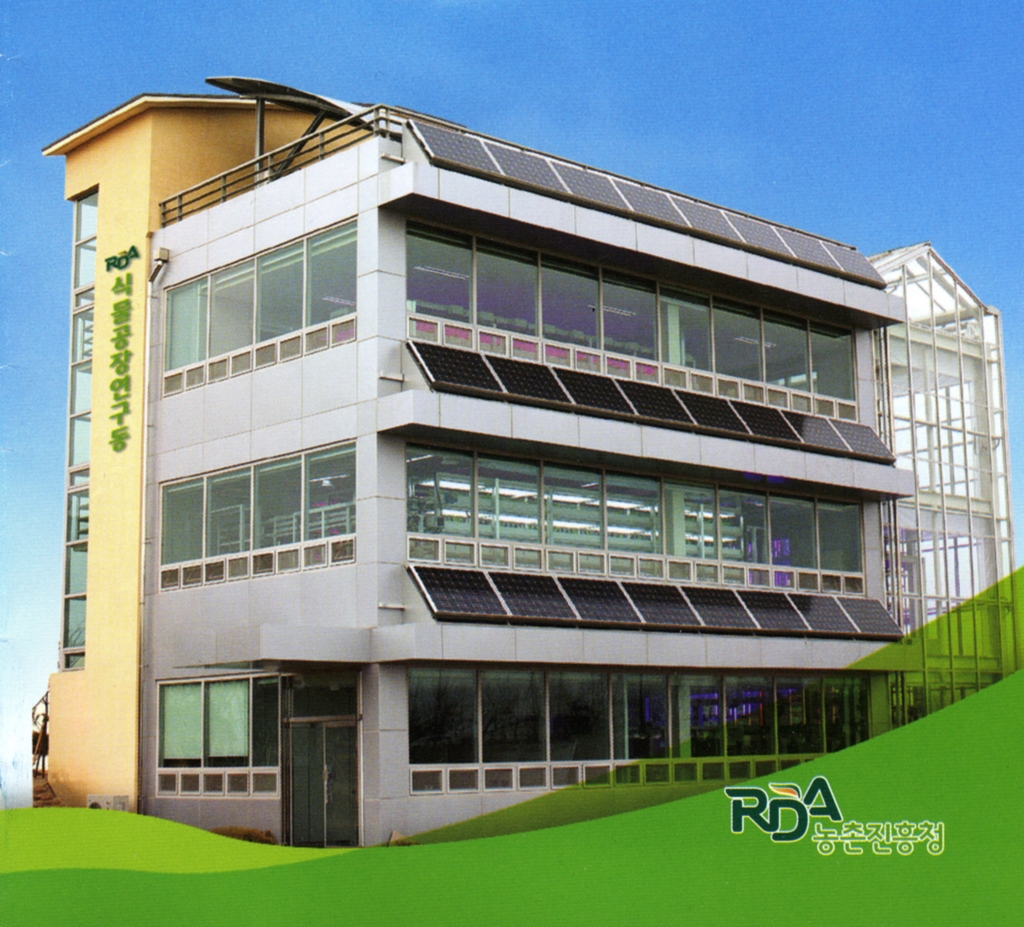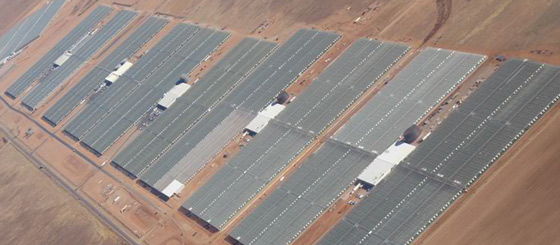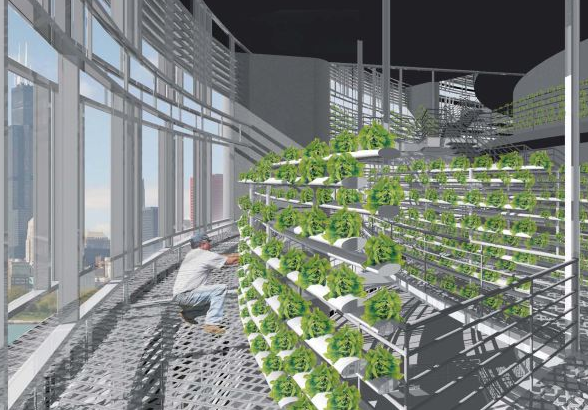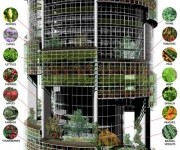 Your classic vertical farm rendering. Rendering: Blake KurasekIf you haven’t seen the slickly rendered architectural models of farms growing in skyscapers, you probably live under a rock. When I first I saw one — this was a few years back, they’ve been making their way around the internet for years — I got a little tingly. Had the clean, green future of food really arrived?
Your classic vertical farm rendering. Rendering: Blake KurasekIf you haven’t seen the slickly rendered architectural models of farms growing in skyscapers, you probably live under a rock. When I first I saw one — this was a few years back, they’ve been making their way around the internet for years — I got a little tingly. Had the clean, green future of food really arrived?
Since then, I’ve come to wonder about how realistic these models are, how likely it is that we’ll ever really move farming out of rural areas and into skyscrapers, and whether it’d really be any better for the environment if we did. How might these models fit into a decidedly less glamorous, but perhaps more collectively drawn, vision of a localized food system that uses fewer chemicals, preserves biodiversity, and employs people fairly?
Dr. Dickson Despommier, author of the The Vertical Farm (just released in paperback), seemed like a great person to go to for answers to these questions. Despommier has a terrific optimism about the potential of these high-rise farms; he sees them as a way to achieve year-round crop production, use less water, reduce agricultural runoff, cut down on food miles, and control pathogens, among other things.
And since the model is based on hydroponics, or water-based growing systems, there’s none of that messy dirt! Seriously, though: Does farming indoors, using LED lighting, make any real sense? Despommier, a retired professor of microbiology and public health in environmental sciences from Columbia University, was gracious enough to answer my questions recently over the phone. Below is an edited transcript of our conversation.
 This experimental, government-run vertical farm in Korea is one of the first to actualize Despommier’s visions.
This experimental, government-run vertical farm in Korea is one of the first to actualize Despommier’s visions.
Q. How did you arrive at the idea to write a book about vertical farming?
A. The idea arose in a class I was teaching. The students expressed dissatisfaction over the fact that all I was talking about was the doom-and-gloom aspects of environmental destruction. They asked me if they could work on something more positive, so I asked them to find out how much food could you grow on the rooftops of New York, and they found that you could only feed about 2 percent of Manhattan that way. They were more bummed out by that result than they were by the other doom-and-gloom we’d been talking about. So I said, why don’t you take your idea and move it indoors so you could grow on multiple levels at once?
I gave similar assignments to my students for several years and finally at around the sixth year we published what we found. That started all kinds of correspondence with people who made drawings and models and got excited about the idea. And then I was approached to write this book. When the hardcover version of The Vertical Farm was published, there were no vertical farms. Now there are at least six farms in the works, including one in Korea (see photo), two in Japan in Quonset huts, and two underway in Holland and England. The mayor of Chicago gave one group there a huge tax incentive to get started with a vertical farm incubator operation there, and there’s also one farm going up in Seattle.
Q. Can you say more about the kinds of companies starting these farms?
A. In Korea the country decided to go into vertical farming research. They want to develop the concept so that entrepreneurs can use what they learn. Otherwise they are for-profit companies. The one in Japan is advertising radiation-free food.
Q. How is the start-up cost different than with a traditional farm?
A. I don’t know. But if you need a tractor, and the equipment that goes with that tractor, a [land-based, rural farm] wouldn’t be any cheaper. The average farmer is so heavily in debt. It’s a tough time in the history of farming. The farmers who I know do it because they love to farm, not to make money.
Q. I’m just wondering what the odds are that someone could get involved in vertical farming on a small, family-farm scale.
A. It depends who you want to feed. If you go online there are a tremendous numbers of growing systems you can buy that would be scalable — anywhere from a household- or restaurant-sized operation, to something that could feed a community of people (just two floors on top of an apartment house would be enough to supply around 40 percent of the green vegetables the residents would consumer over a year).
Ten years ago there were very limited resources for people wanting to get involved in hydroponics; now they sky is the limit. In my book I mention a big hydroponic farm in Arizona named EuroFresh. It’s a 300-plus-acre production.
 Eurofresh Farms greenhouses in Wilcox, Ariz.Q. A lot of eaters want to move away from industrial food production, but these giant models look pretty industrial. The other question I have is about transparency. The photo of EuroFresh in your book makes it look almost like a Confined Animal Feeding Operation (CAFO) from above. It’s clearly very closed off from the public.
Eurofresh Farms greenhouses in Wilcox, Ariz.Q. A lot of eaters want to move away from industrial food production, but these giant models look pretty industrial. The other question I have is about transparency. The photo of EuroFresh in your book makes it look almost like a Confined Animal Feeding Operation (CAFO) from above. It’s clearly very closed off from the public.
A. Remember these companies have worked out how to do this to make a profit. And they’re hardly in the market to share that information. Just like you can’t walk into General Motors and find out how they put their transmissions together. That’s true for outdoor farmers, by the way.
Q. Well, there are more and more small-scale farmers who are finding success by creating more transparency with the people who buy their food — they talk directly about their growing practices and show interested customers exactly what they’re doing.
A. That’s why universities like UC Davis or the University of Arizona are great places to go to learn about these types of growing systems. Don’t go to the private producers, because they’re in business to have a competitive edge.
But if a bunch of people got together and put gardens on top of their apartment houses, they’d eventually show a profit or see a reduction in water or food costs. At that point it can become transparent. I could show you a few of those [models] elsewhere — but there aren’t many in this country.
 Rendering: Blake KurasekQ. I guess that makes me curious about how one of these farms might try to reach folks who are getting accustomed to eating locally and knowing their farmers.
Rendering: Blake KurasekQ. I guess that makes me curious about how one of these farms might try to reach folks who are getting accustomed to eating locally and knowing their farmers.
A. Where I live there a lot of crops that you can’t get ahold of during the winter. So indoor farming allows for more variety.
I know a lot of chefs in New York City who won’t cook with foods that aren’t locally grown and seasonal. That means in the wintertime you’re eating a very different set of menu items than you are in the summer.
That might be okay to some people, but restaurants are not going to be the salvation for the next 3 billion people who are coming up over the next 40 years. I totally agree with Michael Pollan’s point of view and I used to recommend his book in my class. But that’s not the solution to world hunger. And he knows it, too.* Because if you go to places like Sub-Saharan Africa and the Middle East, where they don’t have any soil, [vertical farms] offer a viable solution for otherwise having to import all your food.
Not that this is the only solution, by the way.
*ed. note: We’re not positive Pollan would agree that building local food systems can’t help feed the world. See him address some of this issue in this debate with a spokesperson from the seed giant Monsanto.
Q. How much of our food do you think should be grown this way?
A. Well, it depends on where you live. If I lived in Iceland I’d grow all my food this way; I wouldn’t import anything. Because energy is not the important issue there — they have geothermal energy, so it wouldn’t matter how efficient the grow lights were. It’s also true for other parts of the U.S. where you have readily available solar or wind energy.
The biggest stumbling blocks to developing this on a large scale is the amount of energy it will consume for the grow lights.
Q. There is something a little strange about compartmentalizing your food production away from soil, wildlife, nature, etc. Based on what you say in the book, it sounds like you’d be fine to completely separate the two.
A. Farming has caused the biggest upset of natural systems that the world has ever experienced. We find ourselves with great parts of South America as farmland, and with lots of global climate change issues that can only be addressed if we have the proper mechanisms in place to take care of them — namely trees. A large corporation like Monsanto isn’t going to start growing trees, so as I see it if I can teach Monsanto how to grow corn and soy indoors, and take up one-tenth of the space or less, maybe there’s some hope.
The biggest issue is how you get food to all these people, and right now what we’re doing isn’t working.
Q. We also waste 40 percent of the food we produce in this country, so that’s a huge part of the equation, and we grow a lot of food for animals. So if we shifted those equations it would go a long way toward feeding more people.
A. You could say that. Some Cornell scientist said that you could feed about 800 million more people if you stopped feeding grain to animals [in the U.S. alone]. You think that’s a lot of people — 800 million? In the next 40 years there will be 3 billion more.
But climate change is everybody’s problem. And I see trees as the simplest leave-the-land-alone-and-everything-will-grow-back solution.
You don’t have to plant them, the tree seeds are in the ground and they’re being inhibited by herbicides. If you were to simply stop farming, they’d come back. I’ve been to Aldo Leopold’s abandoned farm, and it’s a great example of what I’m taking about.



